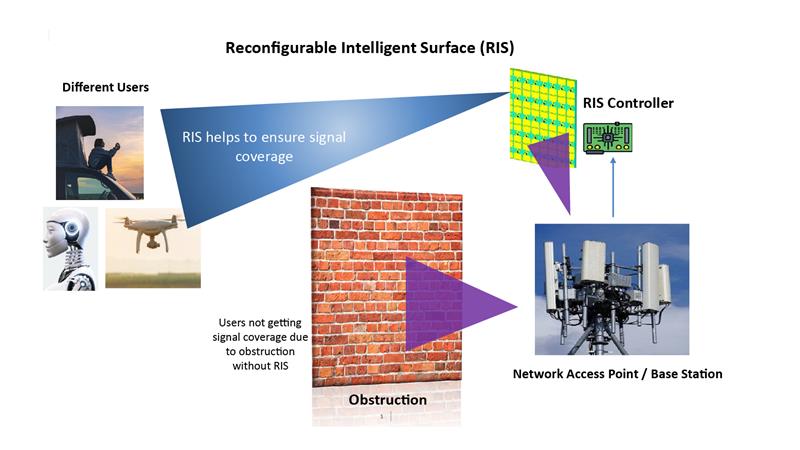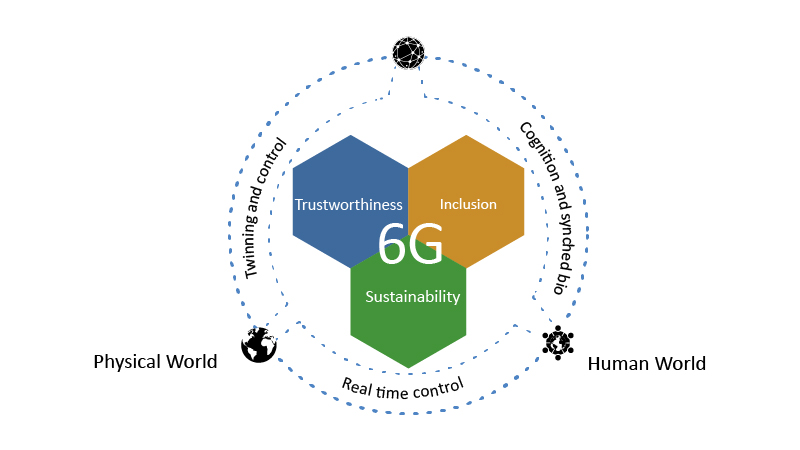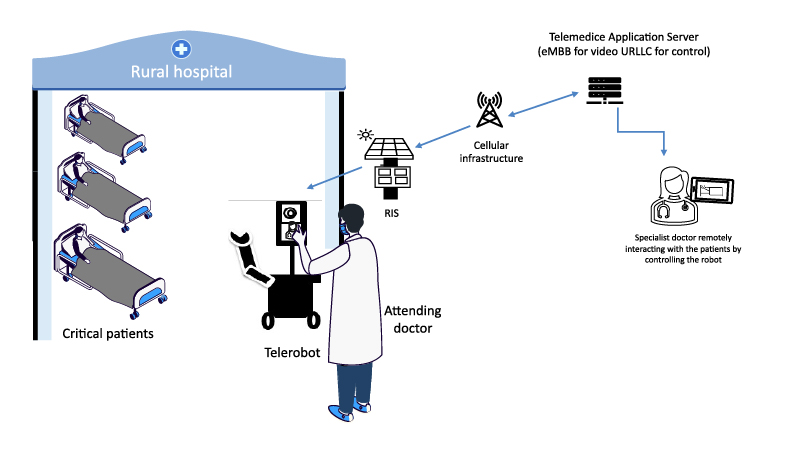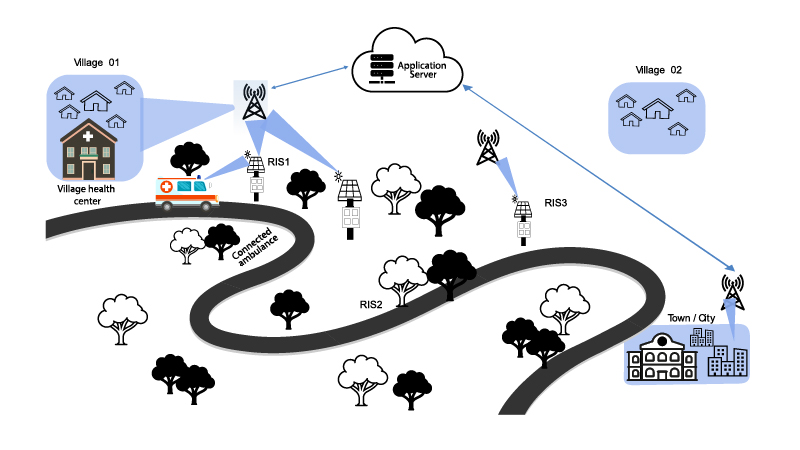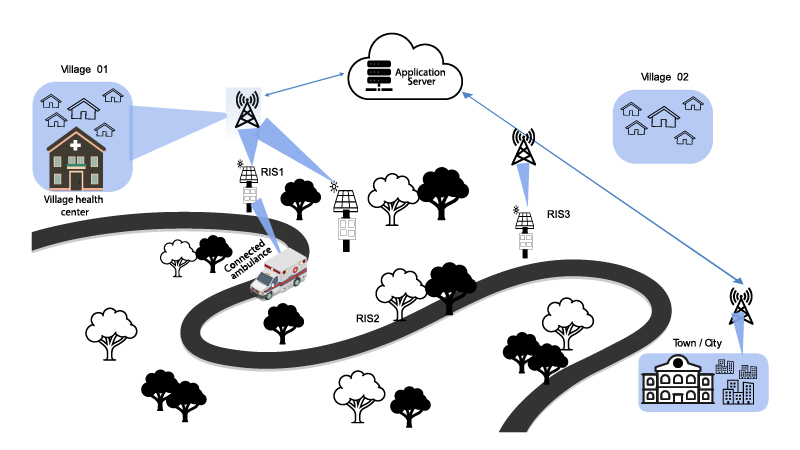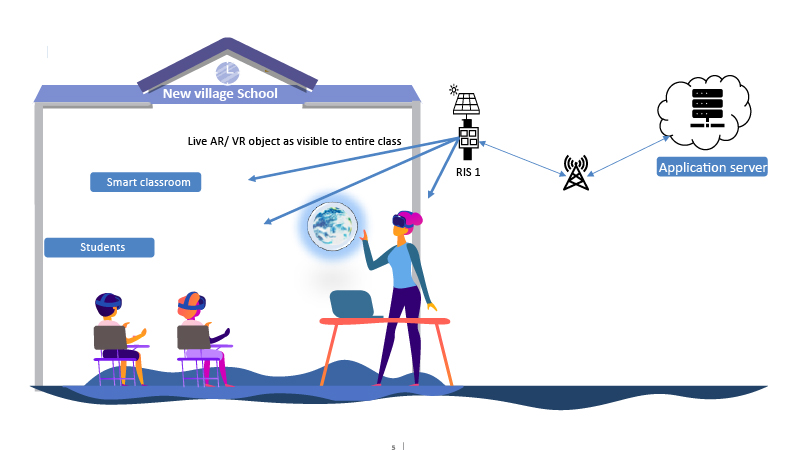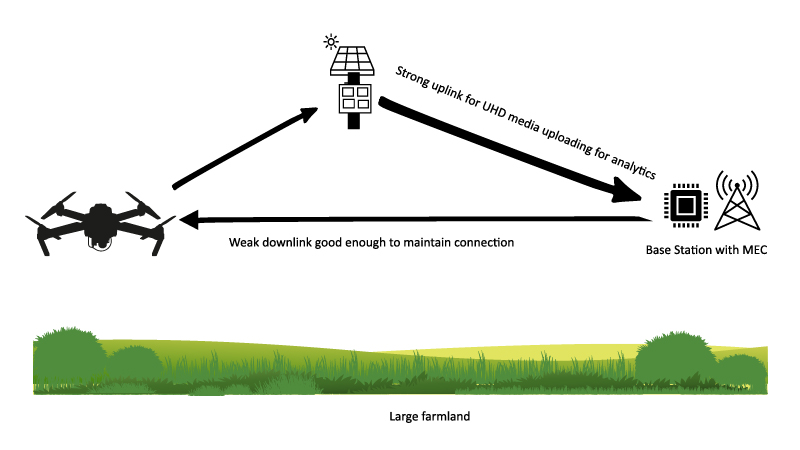Services
Highlights
- 5G and 6G technologies promise the necessary ultra-low latency and enhanced network bandwidth essential for many vertical applications in the domains of extended reality, industrial machine control, networked AI, and so on.
- Such systems require very high frequencies, which typically belong to ‘millimeter wave and beyond’ spectrum.
- Such high frequency signals, however, suffer from low-penetration and quick decay which limit the effective signal range, making scalable deployment of 5G and 6G services a challenge.
- A reconfigurable intelligent surface (RIS) is a low-power, low-cost technology that can help circumvent such propagation challenges through intelligent beam forming. This would enhance the signal quality for the users requiring high-end solutions enabled by 5G and 6G.
What is RIS and why are we talking about it?
Reconfigurable intelligent surfaces (RIS) are advanced hardware structures designed to control the reflection of electromagnetic waves
These surfaces consist of programmable meta-atoms or unit-cells that can dynamically adjust their electric and magnetic properties as per the signals received from an RIS control unit (RCU). By strategically placing RIS in the radio channel between a transmitter and receiver, we can steer signals to improve reception and link quality.
RIS can enhance wireless communication by directing signals to remote areas, increasing range, and improving energy efficiency. They can be implemented using meta surfaces or antenna arrays. Meta surfaces are thin dense arrays of structural elements, such that each element's properties, such as phase and amplitude, are controlled by integrated electronic components like varactors or PIN diodes. The antenna arrays are electrically tunable reflecting structures. Figure 1 illustrates the concept of RIS using a meta surface and an associated RCU for different types of user equipment.
The promised future
Starting from 5G networks, while progressing rapidly to 6G, technology has promised many exciting futuristic applications in the realms of metaverse, digital twins, Industry 4.0, and Industry 5.0. The underlying technology domains broadly include extended reality (XR), time sensitive networking (TSN) for machine control in manufacturing plants, collaborative robots, massive IoT sensing and actuations, and so on. These require extremely reliable connectivity with high bandwidth as well as low latency. Effective deployment of such applications depends on the successful practical realization of two important services – enhanced mobile broadband (eMBB) and ultra reliable low-latency communication (URLLC).
While these are yet to be fully realized in commercial deployments, 6G carries this vision forward and adds two important targets. 6G integrates sensing with communication – this is called joint communication and sensing (JCAS). Also, 6G aims to achieve the sustainable technology targets in alignment with the United Nations Sustainable Development Goals (UN SDG).
Figure 2 shows the three principles based on which a 6G system ought to be designed: trustworthiness, inclusion, and sustainability. Functionally, a 6G system will allow applications to create digital replicas of physical systems through digital twins, and allow human users to seamlessly transition from physical world experience to digital world. JCAS will play a pivotal role in realizing such a future through real-time sensing of the physical world and transferring the same for replication in the digital twins.
The hindrance posed by the laws of physics
But there is a challenge posed by the inherent theoretical limits of electromagnetic wave (EM wave) communication. To achieve the required bandwidth and capacity for eMBB and URLLC, 5G and 6G systems must operate in a very high-frequency spectrum called millimeter wave (mmWave). However, at such high frequencies, the transmitted signal decays very fast and is susceptible to impairment due to environmental factors like dust and water particles floating in the air. These are also poor in terms of penetrating solid obstacles like concrete walls, trees, and so on. So, in the most practical sense, services at such high frequencies are severely limited by range and mobility. Also, at such high frequency, the signal power needs to be controlled to honor the constraints related to allowable human exposure to electromagnetic field (EMF) radiation. So, we end up in a deadlock as far as delivering the promise of 5G and 6G is concerned.
RIS as the silver lining
Though the research community has been exploring RIS for a long time, the imminent challenges in future generation networks, as described above, have reinforced the relevance of this technology at the present time. [ss1] [AB2]
RIS enables us to program the radio propagation environment based on the end user’s demand. It introduces new opportunities for exploring different types of business cases and offers for network designers, telecom operators, telecom infrastructure providers as well as end-to-end application developers.
Preliminary studies show that RIS can help to fulfill the goals of sustainability and EMF radiation constraints while ensuring the quality of service (QoS) for the end user. At the same time, it can help achieve radio sensing without using additional radar technologies. With all these aspects RIS has drawn worldwide attention to reimagine enterprise as well as public service applications.
Some end-to-end application scenarios
RIS boosts the viability of the service or solution, as well as helps explore new possibilities.
Let us take a close look at some end-to-end application scenarios empowered by RIS in the last mile. We put particular emphasis on scenarios in which setting up an on-demand cellular infrastructure may not yield sufficient RoI.
Telemedicine
Rural, on-demand telemedicine services can be a boon for patients residing in areas with unreliable or poor connectivity. RIS installation would ensure proper quality of service (QoS) for establishing high-definition virtual sessions with doctors in speciality hospitals. Figure 3 extends the imagination further by integrating futuristic telemedicine with telerobotics empowered by RIS in the last mile.
Healthcare
RIS can be strategically placed to ensure seamless coverage with proper QoS guarantee in the pathway of smart, connected ambulances running between city hospitals and rural health centres. Figure 4 shows a hypothetical connected ambulance travelling through zones which are not covered by cellular service, yet connectivity is maintained through RIS.
Education
A new school setup may suffer from poor cellular coverage, but leveraging RIS installation may secure the necessary QoS for extended reality (XR) experience to run smart classes (see Figure 5).
Agriculture
Agriculture drones requiring live AI analytics with multi-access edge computing (MEC) while flying over a large farmland may leverage dedicated RIS installation (see Figure 6).
Manufacturing
Smart factories and warehouses deploy connected robots and IoT sensors that need precisely timed communication for synchronized actions. But such environments also suffer from unpredictable radio coverage due to sporadic changes in the radio propagation environments, undue interference, and more. Well-planned RIS installation can help maintain QoS guarantees at the desired areas involved in critical operations.
Given the wide array of applications RIS technology offers, it is only natural to evaluate its economic viability before going whole hog into adoption. Recent research suggests that when compared to installing a new cellular infrastructure to circumvent radio blockade or extend coverage area, RIS may turn out to be a whopping 50% to 80% cheaper depending on the coverage area, RIS size, RIS type, and so on. This is because it is built on the principles of passive reflection, which draws only few watts of power. This means RIS is not just relatively less expensive an option, it also is the more sustainable one given its low-carbon footprint. Moreover, this makes for easier and quicker on-the-go installation.
The need for research
RIS is an evolving technology, with many aspects yet to be resolved for practical commercial deployments.
Some of the issues pertinent to ongoing research across industries and academia are as below:
- Simultaneous tracking of user equipment while communicating: RIS reflects the incident signals as a narrow beam toward the desired equipment. The RIS should also be able to steer the reflected beam following the movement of the equipment. This needs sensing the equipment position in real time, without stopping ongoing communication. This is difficult to achieve without interrupting the ongoing data communication. Researchers worldwide are trying to solve this problem; many researchers are coming up with potential ideas in both RIS hardware and software intelligence.
- Reduction in control-plane overhead for dynamic reconfiguration: As RIS must constantly align the beam according to the mobility of the users, a lot of control-plane signalling needs to happen among the radio access point, RIS, and user equipment. Also, RIS discovery will need several control-plane exchanges. The communication software must take care to optimize the control-plane overheads for better utilization of the network resources.
- Multi-user support: At present, most of the research is being carried out considering RIS targeting a single user equipment. But, in a practical scenario, a single RIS may need to support multiple equipment with different mobility patterns and QoS requirements. Satisfying such complex situations may be difficult. Initial deployments may apply certain limits.
- Lightweight AI-based intelligent control: As part of reducing control-plane overhead and improving overall intelligence, researchers are also trying to apply on board lightweight AI-based mechanisms for autonomous intelligent beam forming by the RIS.
- Full duplex (simultaneous uplink and downlink) operation: At present, RIS hardware is manufactured for a dedicated frequency band. But practical systems will have to support range extension for both uplink and downlink which are on different frequency bands. It is a challenge to support such full-duplex operation without increasing both the cost and size of the RIS infrastructure.
- Operator isolation and other regulatory controls: In a practical scenario with multiple network operators, RIS installed by one operator should not reflect or interfere with signals from another operator serving in the same location. So, appropriate signal-selection mechanism and proper regulatory control needs to be instituted before the commencement of commercial usage.
What next
RIS is no less than a technological revolution that can help realize the vast potential of advanced 5G and 6G.
As we prepare for the 6G future, we believe that the choice of advanced critical network components, like the adoption of RIS, is heavily based on geographical and economic factors. RIS technology would have the most use in the developing world. Besides rural regions, developing nations also face erratic radio propagation due to unplanned urbanization causing unexpected blockades even after rigorous radio planning. RIS promises to deliver a cost effective and agile solution to realize futuristic high bandwidth and low-latency operations. However, scalable and flexible commercial realization would need a careful consideration and resolution of the various challenges discussed here, which is why RIS today is a focus area for research across the globe.


